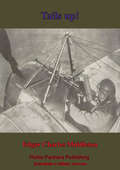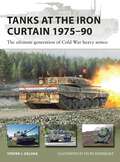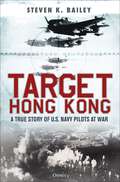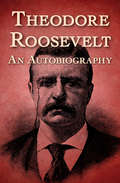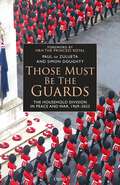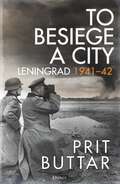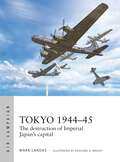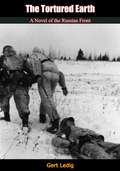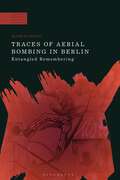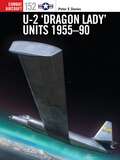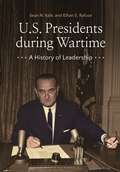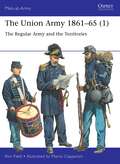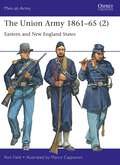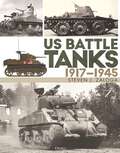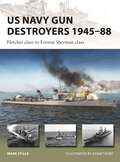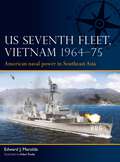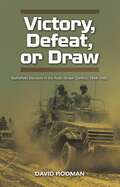- Table View
- List View
Tails Up!
by Colonel John Buchan Edgar Charles MiddletonThe battle in the air above the trenches has held an enduring fascination for generations; the plane itself was only a new development when the First World War started and the pioneers sought to gain any advantage in the skies over their opponents. Edgar Middleton wrote copiously on the subject as well as active air service was involved with the Aeronautical Institute of Great Britain, in this book he records in sketches and anecdotes the reality of the air-war.The author was a well-respected and long-serving war correspondent of the air war for such papers and magazines as Cassell’s Magazine, Daily Chronicle, Daily Express, Evening News, Flying, New York Sun, and The Star.Author — Middleton, Edgar Charles, 1894-1939.Foreword— Colonel Buchan, John, 1875-1940.Text taken, whole and complete, from the edition published in London: Simpkin, Marshall, Hamilton, Kent, 1918Original Page Count – 314 pages
Tales of Aztlan, The Romance of a Hero of Our Late Spanish-American War, Incidents of Interest from the Life of a Western Pioneer and Other Tales
by George HartmannTanks at the Iron Curtain 1975–90: The ultimate generation of Cold War heavy armor (New Vanguard #323)
by Steven J. ZalogaA comprehensive, illustrated account of the new generation of advanced tanks to emerge during the last 15 years of the Cold War, showcasing major improvements in armor protection, gunsights, and fire-control systems.Focusing on the technology of the period, author Steven J. Zaloga explains how the demands of a potential Cold War battlefield spurred the development of the 20th century's most advanced tanks. He considers the final versions of the Soviet T-72, T-64, and T-80 and assesses their strengths and weaknesses. He also explores how the failure of the US-German MBT-70 project led to America's development of the M1 Abrams tank, and to Germany's all-new Leopard II. The British development of the Challenger tank is also considered, as is the lesser-known Leclerc tank developed by France, the smallest and lightest of any of the western designs. Featuring superbly detailed new illustrations and many photos, this volume pinpoints the key technology of the era, including turbine engines, APFSDS ammunition, advanced armor and high-tech fire-control systems, and describes how the rival tanks compared in the final stretch of the Cold War arms race.
Tanks on Iwo Jima 1945 (New Vanguard #329)
by Romain CansièreAn award-winning US Marine Corps armor historian's account of the role of US and Japanese tanks on Iwo Jima. The battle of Iwo Jima is iconic and known for its brutality: this was the only battle in which the number of US casualties outnumbered those of the Japanese. But as is often the case with the Pacific campaigns, the tank action on the island has generally been overshadowed by that of infantry. The tank, however, played an important role as a support weapon – especially on the US side – despite the rough terrain and unconventional enemy tactics. Using unpublished official records and veterans' accounts, award-winning USMC armor specialist Romain Cansière sheds new light on Japanese and USMC armored operations on the island. This book offers new information on the battle in a complete, concise, and accessible format, and its illustrations include unpublished photographs from private collections and meticulously researched new color profiles, highlighting the tanks' modifications and their diverse camouflage and markings.
Target Hong Kong: A true story of U.S. Navy pilots at war
by Steven K. BaileyBrought to life by the personal accounts of six Navy pilots and one British POW, this is the history of the U.S. Navy airstrikes on Japanese-held Hong Kong.Commander John Lamade started the war in 1941 a nervous pilot of an antiquated biplane. Just over three years later he was in the cockpit of a cutting-edge Hellcat about to lead a strike force of 80 aircraft through the turbulent skies above the South China Sea. His target: Hong Kong. As a storm of antiaircraft fire darkened the sky, watching from below was POW Ray Jones. For three long years he and his fellow prisoners had endured near starvation conditions in a Japanese internment camp. Did these American aircraft, he wondered, herald freedom? Trawling through historic records, Steven K. Bailey discovered that the story of the U.S. Navy airstrikes on Japanese-held Hong Kong during the final year of World War II had never been told. Operation Gratitude involved nearly 100 U.S. Navy warships and close to a thousand planes. Target Hong Kong brings this massive operation down to a human scale by recounting the air raids through the experiences of seven men whose lives intersected at Hong Kong in January 1945: Commander John D. Lamade, five of his fellow U.S. Navy pilots and the POW Ray Jones. Drawing upon oral histories, diary transcripts, and U.S. Navy documents, this book expertly narrates the intertwined experiences of these servicemen to bring the history to life.
Theodore Roosevelt
by Theodore RooseveltThe firsthand account of the life of adventurer, scholar, war hero, and twenty-sixth president of the United States Theodore Roosevelt.There must be the keenest sense of duty, and with it must go the joy of living. Here, in his own words, Theodore Roosevelt recounts his remarkable journey from a childhood plagued with illnesses to the US presidency and beyond. With candor and vivid detail, this personal account describes a life guided by a restless intelligence, a love for adventure, and an unflagging duty to his country. Roosevelt sheds light on his wide array of roles, from New York police commissioner, where he waged a battle against corruption, to cattle rancher in the Dakotas to assistant secretary of the US Navy under William McKinley to leader of the legendary Rough Riders at the outbreak of the Spanish–American War, when he led the 1st United States Volunteer Cavalry to victory in the Battle of San Juan Hill. These extraordinary accomplishments earned Roosevelt national fame and set the stage for his ascent to the White House. As twenty-sixth president of the United States, he ushered in the Progressive Era with his domestic policies, such as the Square Deal, and trust-busting of monopolies, such as Standard Oil. He was a war hero, scholar, statesman, adventurer, and Nobel Peace Prize winner. Theodore Roosevelt: An Autobiography provides unique insight into the truly remarkable life of one of America’s most beloved presidents. This ebook has been professionally proofread to ensure accuracy and readability on all devices.
Theodore Roosevelt: An Autobiography
by Theodore RooseveltTheodore Roosevelt: An Autobiography recounts the decorated soldier and esteemed politician's life from his earliest remembrances through his years as a Rough Rider and his eight years in the White House.Be it mystery, romance, drama, comedy, politics, or history, great literature stands the test of time. ClassicJoe proudly brings literary classics to today's digital readers, connecting those who love to read with authors whose work continues to get people talking. Look for other fiction and non-fiction classics from ClassicJoe.
Those Must Be The Guards: The Household Division in Peace and War, 1969–2023
by Paul de Zulueta Simon DoughtyThe story of the British Army's Household Division from 1969 to 2023. It is the biography of a family of three generations of soldiers who have served Crown and Country during a period of significant social and geostrategic change.The story of the British Army's Household Division from 1969 to 2023 is one of three generations of soldiers who have served Crown and Country during a period of significant social and geostrategic change. It is the story of a family of seven regiments that symbolise the Union of Great Britain and Northern Ireland, Septem juncta in uno: The Life Guards, The Blues and Royals, Grenadier, Coldstream, Scots, Irish and Welsh Guards. The Guards established an ascendancy in the Peninsular War and at the Battle of Waterloo, and have never truly faltered since. They have managed this by changing when change was needed. Over the last 50 years, the Household Division has been at the centre of almost every major operation conducted by the British Army: Northern Ireland, the Falklands, the Balkans, Iraq and Afghanistan. At the same time, the Household Division is a national institution, admired by the public through its mastery of ceremonial and pageantry, and the magnificent hour that is Trooping the Colour. The professionalism and self-discipline of the individual Guardsmen and Troopers are what ensures both their exemplary performance on operations and their high standards of state ceremonial and public duties. Those Must Be The Guards illustrates both roles through the experiences of those who have served in the Household Division over the past half-century.
The Time Machine Next Door: Rebellions and Super Boots (The Time Machine Next Door)
by Iszi LawrenceA page-turning, laugh-out-loud historical adventure by comedian and broadcaster Iszi Lawrence, perfect for fans of Horrible Histories.Time flies when you're having fun. But what does it do when you're not?Sunil and his not-very-normal next door neighbour Alex are back for another hilarious adventure as they whizz through time. This time Sunil and Alex find themselves tangled up in British civil wars, from the Roman invasion to the Battle of Bosworth in 1485 and their very own witch trial in the 1640s. As if that wasn't enough to deal with, there's double the trouble with Alex-from-the-future and her shiny boots running around too! Will Sunil, Alex and Alex-from-the-future ever get home? And will Mr Shaykes and his pet kiwi ever leave them alone?!_______________The Time Machine Next Door is an exciting new series of quirky historical chapter books for readers aged 7-9, to be enjoyed as a series or as standalone stories. Written by comedian, podcaster and children's author Iszi Lawrence, these books bring lesser-known parts of history to life with hilarious plots, real-life characters, fascinating facts and fantastic illustrations._______________
To Besiege a City: Leningrad 1941–42
by Prit ButtarA ground-breaking history of one of the greatest ever sieges. Masterfully brought to life by a leading expert using original Russian and German source material.'[An] excellent account.' - Richard Overy, The Telegraph This new history of the first two years of this crucial battle for the heart and soul of Russia is the first in over a decade and also the first to look comprehensively at the wider military strategies of both sides. At a huge cost, the Red Army and the civilian population of Leningrad ultimately endured a bitter 900-day siege, struggling against constant bombing, shelling, and starvation. Throughout the siege, Soviet forces tried to break the German lines and restore contact with the garrison. To Besiege a City charts the first of these offensives which began in January 1942 and was followed by repeated assaults. Acclaimed Eastern Front historian Prit Buttar details how although the Red Army suffered huge casualties in the swampy and forested terrain, the German infantry divisions were also steadily eroded. Indeed, by keeping control of parts of the shores of Lake Ladoga, the Soviet Union was able to sustain Leningrad through the winters of the siege via the 'road of life', constructed across the frozen lake. This epic history details the dramatic race to create the road across the ice and first-hand accounts from both Soviet and German soldiers, many never previously translated, bring the horrific series of battles and assaults to life. Ultimately the determination of the defenders to hold out during this first phase of the siege and the desperate attempts to break it became a hugely significant part of Russian wartime history. The echoes of the battle persist to this day helping to define both a country and its politics. There is no better time to fully understand this history and To Besiege a City is the most comprehensive account to date.
Tokyo 1944–45: The destruction of Imperial Japan's capital (Air Campaign #40)
by Mark LardasThe full history of how the United States targeted and destroyed the Japanese capital from the air, in a ten-month long campaign by the US Army Air Force and the US Navy.In November 1944, the US Army Air Force launched a 111-plane B-29 strike against Tokyo, the first raid since the morale-boosting Doolittle Raid of 1942. From then until August 13, 1945, the United States would attack Tokyo 25 times, 20 from B-29s based in the Marianas and five from US Navy carrier task forces. The campaign included the single deadliest air raid in human history, when around 100,000 people were killed by the firestorm created by the Operation Meetinghouse raid of March 10, 1945. This book, the first to examine the full history of the United States' air campaign against the greatest target in Japan, looks at the USAAF's and US Navy's efforts to use air power to eliminate Tokyo's strategic value to the Empire. It considers how the campaign developed from daylight bombing to firebombing and anti-ship mining, and finally how the target was handed over to the US Navy, whose carrier-based bombers and fighter-bombers continued to strike Tokyo during July and August 1945.Using specially commissioned battlescenes, strategic maps and diagrams, this volume presents a detailed picture of how Tokyo was vanquished from the air.
The Tortured Earth
by Gert Ledig Mervyn SavillAs the corporal stuffed the loose dirt into the exhaust pipe of the tank he realized how futile his effort was, but it gave him enormous satisfaction anyway—somehow he was striking back. The runner kept fingering the leaflet in this pocket, the leaflet guaranteeing him safety if he deserted the enemy, and wondering in his terror what to do. The counter-offensive for hill 608 had failed, and the company was almost totally wiped out. The major had ordered the attack knowing it to be hopeless, in a mood of revenge, for he had just learned his wife and daughter had been killed.With the enormous power of a human soul profoundly outraged by the calculated inhumanity of war, Gert Ledig has pounded out the most shattering novel of World War II…The Tortured Earth was first published in Germany, where it became an immediate bestseller and was received by all critics, without reservation, as “the best novel of the war.” One reviewer wrote: “Ledig’s book is at one and the same time brutal and sensitive, cold and immensely sympathetic, raw and yet hopeful.”
Traces of Aerial Bombing in Berlin: Entangled Remembering (A Modern History of Politics and Violence)
by Dr Eloise FlorenceThe destruction of monuments during the Black Lives Matter movement of 2020 shows how many nations are being forced to grapple with their national histories. It is clear that the things which make up our streets form a core part of our historical, political and cultural identity. Here, Eloise Florence turns to Berlin and the deeply entrenched English-language narratives about World War II to explore the complicated relationship between violence, place and memory in the Anglo-American consciousness. Centered upon Teufelsberg – a hill in Berlin born from the rubble caused by Allied bombing – and other sites of violence across Germany's capital, this interdisciplinary study unpicks the use and abuse of area bombing and its cultural memory in Anglo-American audiences. Grounded in theories of new materialism and post-humanism, and drawing on extensive empirical and auto-ethnographic data, the issues addressed include: moving through urban landscapes as an embodied means of memorializing war and trauma; remembering destruction as a means to advance or challenge traditional war mythologies; and curation as an entry point for tourists to reconsider the impact of British and American aerial raids, including modern drone warfare. This innovative volume shines an important light on both the dark legacy of the aerial bombing of Berlin and the ways in which we record and read violent histories more generally. As such, Traces of Aerial Bombing in Berlin will be an invaluable resource for all scholars of World War II, memory culture and public history.
U-2 ‘Dragon Lady’ Units 1955–90 (Combat Aircraft #152)
by Peter E. DaviesAn illustrated account of the early service of the Lockheed U-2, one of the most important and longest-serving intelligence gathering platforms fielded by the US air force.The U-2 is one of the most recognizable aircraft of the Cold War; nicknamed the 'Dragon Lady' after the codename given to it by the CIA, this powered glider was designed and operated in great secrecy, providing US authorities with photographic and electronic information from areas of interest across the globe. This illuminating new volume dives deep into the U-2's most critical missions, exploring its role in the Cuban Missile Crisis, nuclear reconnaissance in the Soviet Union, and intelligence missions in China and North Vietnam.Using previously unpublished research, aviation expert Peter E. Davies examines the operations of one of the landmark aircraft of the 20th century from a fresh and engaging perspective, enhanced by more than 50 photos and 21 newly commissioned profile artworks.
U.S. Presidents during Wartime: A History of Leadership
by Sean N. Kalic Ethan S. RafuseFrom the American Revolution to the War in Afghanistan, the United States has had no shortage of conflicts on both domestic and world stages. All provide insight into the values of the presidents who led the nation through them.U.S. Presidents during Wartime: A History of Leadership takes readers through chronological entries of presidents who participated in key wars throughout U.S. history. An overview essay first considers the social, economic, and political factors that affected presidents during war. Entries beginning with the presidency of George Washington and ending with that of George W. Bush comprehensively cover each war therein, as well as the responses of the relevant presidents.Primary documents in each entry depict the perspectives of the presidents and offer opportunities for comparing and contrasting the presidents' engagements in wartime strategies. Ending each entry are chronologies of the various events and conflicts that marked the president's time in office. Moreover, entries build upon each other to help readers toward a broader understanding of the sum impact of the wars that the presidents led. While the book emphasizes the historical record, it also explores ongoing conflicts through the lens of contemporary U.S. presidents to provide readers with a complete picture of the changing nature of war over time.
The Union Army 1861–65: The Regular Army and the Territories (Men-at-Arms #553)
by Ron FieldThis fully illustrated study investigates the uniforms and equipment of the US regular troops and volunteers from the territories fighting for the Union during the American Civil War.During the American Civil War, the United States Army, pitted against the forces of the fledgling Confederacy, fought to defend and preserve the Union during five long years of bitter conflict. This volume describes and illustrates the uniforms, insignia and personal equipment of the Union Army's regular infantry, artillery, cavalry, and engineers, plus specialists such as US Sharpshooters, Veteran Reserve Corps, Medical Corps, and Signal Corps.This volume also covers the troops fielded by the Territories that fought for the Union. Eight plates of original artwork showing officers and enlisted men of the Union Army are complemented by previously unpublished photographs of soldiers and items of uniform from some of the most comprehensive collections in the United States.
The Union Army 1861–65: Eastern and New England States (Men-at-Arms #555)
by Ron FieldThis book describes and illustrates the uniforms and personal equipment of the troops fielded by the Eastern and New England states that fought for the Union during the American Civil War. During 1861–65, the United States Army, pitted against the forces of the fledgling Confederacy, fought to defend the Union during five long years of bitter conflict. This volume, the second in a three-part study, chronicles the clothing, insignia and gear worn by the soldiers fielded by 12 of the states that fought to preserve the Union. While uniforms conforming to standard Union Army patterns were widely issued to these troops, some wore distinctive items of dress or insignia, and a wide variety of weapons were carried. Ron Field, an acknowledged authority on US military apparel, reveals how the Eastern and New England states clothed and equipped their regiments during the Civil War. Eight plates of original artwork showing officers and enlisted men of the Union Army are complemented by photographs of soldiers and items of uniform from a variety of sources.
US Battle Tanks 1917–1945
by Steven J. ZalogaA comprehensive and detailed illustrated examination of the development and combat performance of US battle tanks from World War I to the end of World War II. In this, the first of two highly illustrated volumes examining the complete history of US Army and US Marine Corps battle tanks, Steven J. Zaloga focuses on the history of the tank in American service from the first experiments with armored vehicles in the early years of the 20th century through to the end of World War II. Expanding on material published in Osprey series including New Vanguard, Campaign, and Duel, US Battle Tanks 1917–1945 explores the concepts and practice of tank development from the Renault FT, through the M4 Sherman to the M26 Pershing. It describes the experiences of the crews who saw combat, the performance of each tank in battle, and how each American armored fighting vehicle compared with the enemy armor it faced, as well as the key lessons learned from combat that led to new concepts and technological breakthroughs.
US Marine vs Japanese Soldier: Saipan, Guam, and Peleliu, 1944 (Combat #77)
by Gregg AdamsFully illustrated, this book assesses the US Marines and Japanese troops fighting in three bloody battles of World War II in the Pacific. In June 1944, the United States military launched an offensive against the Japanese forces holding the Mariana Islands and Palau. The US Marine Corps played a vital role in this campaign alongside Army and Navy forces, while their Japanese opponents mounted a desperate defense of their conquests amid the harsh island terrain. This book assesses both sides' doctrine, tactics, weapons, and battlefield effectiveness in three battles of this stage of the Pacific War. Landing on Saipan on June 15, the Marines established a beachhead as the Japanese defenders strove to fight to the last man. On July 21, US Marine Corps and Army forces landed on Guam. Only on August 10 was Guam declared secure by the Americans, and even then resistance continued. US forces landed on Tinian on July 24 and wrested the island from its conquerors. Alongside Army troops, the US Marine Corps also targeted the island of Peleliu. Predicted to last four days, the US assault on Peleliu lasted more than two months as the defenders inflicted appalling US casualties. Featuring all-new artwork and mapping alongside archive photographs, this study assesses the tactics and technology employed by the Marines and their Japanese opponents in these bloody battles, as the Pacific War moved toward its grim climax.
US Navy Gun Destroyers 1945–88: Fletcher class to Forrest Sherman class (New Vanguard #322)
by Mark StilleAn illustrated history of the long Cold War careers of the US Navy's last gun destroyers, from the modernized World War II-era Fletcher-class to the Forrest Sherman-class. The finest American destroyers of World War II had surprisingly long careers into the Cold War and the missile age. The 175-strong Fletcher-class was the largest class of US Navy destroyers ever built, and most received some modernization after World War II. A handful were converted into ASW (Anti-Submarine Warfare) escorts and one was even converted into the US Navy's first guided missile destroyer. Many Sumner-class destroyers were also kept in service, with the last decommissioned in 1973. The Gearing class was the classic US Navy wartime destroyer to have a second Cold War career, some being modified into picket ships and others into ASW escorts. Ninety-five were extensively modernized under the Fleet Modernization and Rehabilitation (FRAM) program which allowed them to serve until 1980. The majority of these ships then saw service with foreign navies. However the story of Cold War gun destroyers is not just one of World War II relics. Commissioned in the 1950s, the 18 ships of the Forrest Sherman class were the US Navy's last all-gun destroyers, and were considered to be the pinnacle of US Navy gun-destroyer design. Later in their careers, most were modernized for ASW and antiair warfare. The virtually unknown Norfolk class was originally built as a destroyer leader and maximized for ASW but only two were modernized and the other three retired early. Many of these ships, such as USS Edson, Cassin Young, and Turner Joy, still survive as museum ships today.Using battlescene artwork, detailed illustrations and photos, this book explores the careers, modernizations, and roles of all these unsung Cold War stalwarts, the last gun destroyers of the US Navy.
US Seventh Fleet, Vietnam 1964–75: American naval power in Southeast Asia (Fleet #4)
by Edward J. Marolda"This is a terrific history of the Seventh Fleet's vital service to the United States in the Vietnam War... remarkably researched and interpreted"- Admiral Jonathan W. Greenert, Chief of Naval Operations, 2011–2015 and Commander Seventh Fleet, 2004–2006"Combines a crisp text by the leading authority on the subject, with well-chosen contemporary photographs, new maps, and excellent art work… an excellent introduction to a complex conflict, and the operational lessons learnt."- Professor Andrew Lambert, Laughton Professor of Naval History, King's College LondonA superbly illustrated examination of how the US Navy's most powerful fleet fought the Vietnam War, covering all of its elements from aircraft carriers and heavy cruisers to minesweepers and oilers.The US Navy's Seventh Fleet was at the forefront of America's campaign in Vietnam for a decade, from the Gulf of Tonkin Incident that began it all to the final evacuation of South Vietnam. Its mission was highly strategic, and while its primary role was to provide carrier-based air power over North Vietnam – from Rolling Thunder through Linebacker – the fleet's operations were complex, sensitive, and varied, and required all the capabilities of the fleet.This book is the first overall examination of how US Navy's most powerful fleet fought and operated in Vietnam. Distilled from thousands of declassified secret documents by renowned US Navy specialist Dr Edward J. Marolda, it offers a unique new portrait of how the Seventh Fleet fought the Vietnam War, from the offensive strike power of naval aviation to the vital role of fleet logistics. As well as the carrier operations, he examines the surface combatant fleet's gunfire support role, and its raids against the North Vietnamese coast. Dr Marolda also looks at amphibious warfare, fleet air defense, search-and-rescue, and mining and interdiction operations. Illustrated throughout with archive photos, 3D diagrams and spectacular new artwork, and informed by never-before-translated official documents, publications, and personal accounts from North Vietnamese, Soviet, and Chinese sources, this is the real story behind the US Navy's Vietnam War.
Vanished Arizona, Recollections of the Army Life by a New England Woman
by Martha SummerhayesI have written this story of my army life at the urgent and ceaseless request of my children.
Victory, Defeat, or Draw: Battlefield Decision in the Arab-Israeli Conflict, 1948-1982
by David RodmanThree outcomes are possible on the battlefield: victory, defeat, or draw. An adversary may defeat or be defeated by its adversary, or neither of the two may emerge victorious or vanquished. Observers of military history have long tried to identify the variables that determine victory, defeat, or draw. While most would certainly acknowledge that decisions on the battlefield are dictated by a combination of variables rather than by a lone circumstance, many observers nevertheless tend to stress a single variable -- for example, the number of fighting men and fighting machines deployed by the adversaries, or the operational doctrines employed by the opposing forces -- as far more significant to the explanations of these decisions than other variables. This book, in contrast, takes a multicausal approach to the question of victory, defeat, or draw, proposing that a combination of six organizational, materiel, and environmental variables are pivotal to the explanation of decision on the battlefield. Using the extensive history of the Israel Defense Forces, the book examines a sample of eight battles across the ArabIsraeli conflict from 1948 to 1982 in order to determine the collective impact of the six variables on the outcomes of these battles, concluding that this basket of variables captures much of the explanation behind victory, defeat, or draw on the battlefield, at least insofar as concerns the record of the IDF. While the research in this book is aimed primarily at military historians and military practitioners, it is fully accessible to any layperson interested in Israeli military history in particular or international military history in general.
